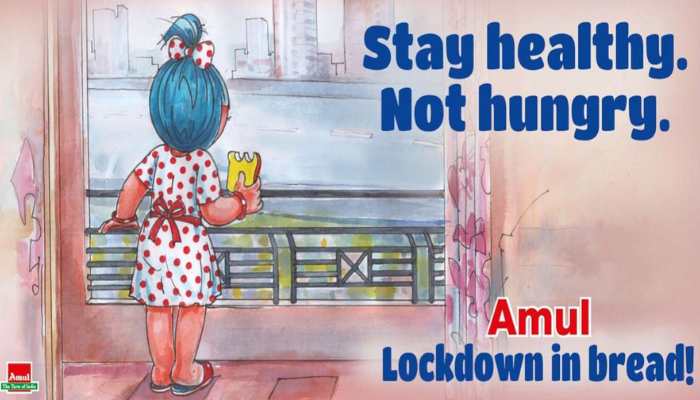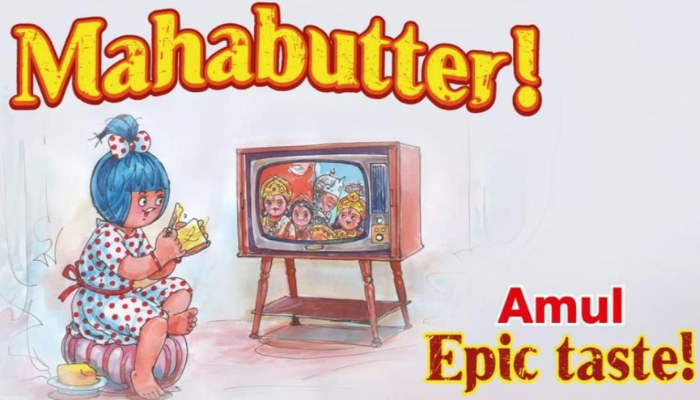How Amul emerged victorious during the lockdown

Ever wondered how Amul kept itself afloat during the lockdown when every other FMCG organization was left scrambling? As strange as it sounds, Amul took the leeway and enhanced its marketing strategy amidst the pandemic induced lockdown instead of choosing to drown when high tide hit.
But how did Amul manage to escape and in turn double its expense on marketing strategies when all else was going downhill? The folks at Amul were very smartly able to turn this challenge into an opportunity. Let’s have a look at it!
Unlocking in lockdown
The country witnessed a turning point like no other on March 25, 2020, when a nationwide lockdown was imposed. What sounded like trouble in its early phase, turned out to be a lot more than that when havoc amongst the local population spilt the streets. A state of ambiguity filled the hearts of many. Amidst this unrest, another concern gripped the country. With restrictions on movement, people had to resort to home-cooked meals, which resulted in an expected surge in the demand of grocery and gourmet items that were otherwise often found few takers. This is where the breaking point occurred, the demand exceeded the supply.
Meanwhile, Amul weaved a different picture. Lying in the essential commodities segment of the industry, the manufacturing of the company’s products did not halt. And so, Amul had the leverage to operate its 84 factories that collected 25 million litres of milk every day for 3.6 million farms in the country. Also, it’s large distribution network of about ten thousand dealers and ten lakh retailers across the country helped the organization play its cards differently.
In fact, if stats be quoted, Amul’s cheese, tetra pack milk, paneer and butter products saw an incredible 30-40% rise in demand in the very first quarter of 2020, most of which can, undeniably, be credited to the change in consumers’ buying behaviour during the lockdown. The demand for packaged foods increased a lot more than that of fresh ingredients. And where packaged products come into the picture, Amul boasted of a 75-year long legacy that helped keep its position intact.
Most of us are unaware of the fact that dairy is the livelihood of as many as 100 million rural families and Amul had to ensure that consumers continue buying dairy products so that it could give back to the farmers.
To make that work, the company incentivised all its supply chain partners in order to maintain a smooth-running network of the supply chain all through the period of disruption. Dr R S Sodhi, Managing Director, Amul, said that the company gave Rs 11,000 crore (US$1.5m) to its farmers during the 80 days of lockdown.
Doubling the Marketing expense
In March, when companies saw a dead end and had to step out from their marketing expense, Amul stood firm and instead of following suit, chose to invest more in this space. As mentioned by Dr R S Sodhi, Managing Director, Amul, the media agency got into a huddle with him to talk about the path forward with respect to advertisements and all he asked them was to focus more on this arena and double the budget which helped Amul crack some good deals.
To everybody’s surprise, the company turned into a superstar in a short span of time. Amul was everywhere - across all channels, no matter the channel you’re tuned in to and a pathbreaking record was established. The organization received an overwhelming response and got benefits that were more than 100x.
The buzz did not stop there. While Amul was practically the only brand advertising during the lockdown, Mahabharat and Ramayan returned to Doordarshan and they surpassed the viewership of everything else that aired on television during that period.
The company then decided to sponsor the two shows at a reasonable price and came up with an ad themed on Ramayana which featured the utterly butterly Amul girl. The traction on its advertisement increased so much that it had 10 times more views than the final match of Indian Premier League at one-tenth the cost.
And this was only the beginning of its revised digital advertising strategy. Since then, Amul started creating Ad campaigns on everything that’s happening in the country and around the world. If we put this in perspective, the ad volumes of Amul in the months of April and May 2020 witnessed an increase of 316% when compared to the numbers of April and May 2019.

The craft of marketing at Amul
When asked about one unique feature of the organization that keeps Amul afloat, Dr R S Sodhi replied with a word, emphasizing on the importance of Consistency. He elaborated further by saying that the brand does not change every year or even in a couple of years because once it takes a position, it believes in keeping it. So, when Amul came up with its famous slogan and tag line “The taste of India”, it represented the brand and so has stayed intact ever since it was penned in mid-1990s.
This has helped Amul play its cards right too. The Managing Director further mentioned that Amul’s topical ad campaign is a crowd favourite and people love the Amul girl. Additionally, all of this has been done by spending a negligible amount of money! The organization’s total spend on advertising amounts to a mere 0.8% of the annual revenue and out of that percentage, the spend on Amul Girl topical ads is about 4-5% of the net advertising budget.
In fact, Amul as a brand has had the same advertising agencies for the last 50 years. So, when Amul boasts about being consistent, it doesn’t apply to its product recipes only. It goes beyond that, looping in people, production and communication.
Fun Fact
Amul’s advertising campaigns began in 1966 with Mumbai’s ad agency, DaCunha Communications. Sylvester DaCunha, the founder and chairman of DaCunha Communications, back in his time, decided to curate an ad campaign for Amul that would be suitable for outdoor hoardings.
That was when the Amul girl, designed by Eustace Fernandes, the art director of DaCunha Communications, witnessed the light of the day. And it was in the same year, 1966, when Sylvester’s wife, Nisha DaCunha, coined the phrase “Utterly Butterly”. While in its initial phases, it was dealt with skepticism as it wasn’t grammatically correct, it later turned out to be the most memorable taglines in the history of Indian advertising!
Outlook for the year ahead
Overall, Dr R S Sodhi said that the next six months will be difficult for the recovery of many categories. As a part of the food industry, Amul is lucky. Because food is the only thing people across the country would spend on during their time in lockdown, it would help branded food organizations like itself rule the market.
In this regard, he goes on to say that he expects the growth to continue with a 15-16% revenue growth for the year 2020. As far as recovery is concerned, India, he mentions, would recover a lot faster than all other countries.
For the near future, the Managing Director of Amul believes that there is tremendous demand in a few product categories, especially where people want packaged and branded products. Amul is looking at how they can increase the capacity to meet that demand and build distribution panels that would serve big cities as well as villages.
Amul has built an irreplaceable place for itself in the industry. What’s surprising to note here is the fact that its strategy wasn’t extraordinary. They simply and carefully understood their target market, identified the right time to give a voice to their brand and then, implement its strategy in place, while it managed the business value chain. It will be riveting to witness the organization spread its wings further once the lockdown ceases to exist.
Login to continue reading
And access exclusive content, personalized recommendations, and career-boosting opportunities.
Blogs you need to hog!

What Innovation Does For Efficiency and Competitiveness in a Corporate Sector?

Online to Offline Commerce- Everything one needs to know

How Do You Work Around Branding Guidelines To Be Guidelines And Not Limitations? | Alekhya, Brand Manager- Vivel, ITC | Dove, Unilever













Comments
Add comment